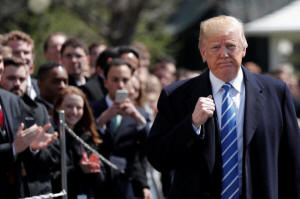|
'We can't just trust': The thinking
behind Trump's get-tough approach to China
 Send a link to a friend
Send a link to a friend
 [April 07, 2018]
By Steve Holland, David Lawder and Jeff Mason [April 07, 2018]
By Steve Holland, David Lawder and Jeff Mason
WASHINGTON (Reuters) - When Liu He, Chinese
President Xi Jinping's top economic adviser, came to Washington in late
February, he was expected to make arrangements for restarting trade
talks that President Donald Trump had put on ice.
But just as Liu arrived, the Trump administration announced global steel
and aluminum tariffs aimed at punishing China for what Washington says
is its overproduction of steel that hurts U.S. steel makers. The
announcement came a day ahead of a meeting planned with Trump's economic
point men, Treasury Secretary Steve Mnuchin and then White House adviser
Gary Cohn.
Pessimistic Trump officials had said the Liu meeting would probably go
nowhere. "People expect that whatever the Chinese offer it will be
insufficient," a White House official told Reuters just hours ahead of
the meeting.
The timing of the announcement, whether deliberately aimed at
embarrassing Liu or not, was emblematic of the Trump administration's
more confrontational approach to what the United States has long viewed
as China's unfair trade practices.
It was the opening salvo in a pattern of escalation that continued this
week as Trump slapped first $50 billion in tariffs on China and then
said he would seek $100 billion more after Beijing struck back.
(Graphic: https://tmsnrt.rs/2GXE9qr)

The rapid tit-for-tat escalation, which has brought the world's two
biggest economies to the edge of a trade war, is being driven by
anti-China economist Peter Navarro and U.S trade negotiator Robert
Lighthizer, who cut his teeth in trade deals with Japan in the 1980s.
Navarro has moved from the sidelines to center stage following the
departure of Trump's economic adviser Cohn, who quit in protest over the
punitive steel tariffs on China. While Cohn shared Navarro's view that
China's unfair trade practices must end, he had instead advocated
enlisting help from Europe and Japan to pressure Beijing, sources said.
Cohn failed to persuade Trump to that point of view. One White House
official said that Navarro is now the dominant voice in the room on
China trade. "Once they (Navarro and Lighthizer) get his (Trump's) ear,
it's hard to walk him back to a more reasonable place," said one person
close to the White House.
Trump does not need much convincing. He has long criticized China's
trade practices and it was a recurrent theme in his 2016 election
campaign. With Cohn and other moderating voices now gone from his
administration, White House officials say he now feels more able to keep
his campaign promises.
Trump's negotiating style, honed in his years as a real estate
developer, is to take extreme positions to force concessions from his
opponents. So far that approach has had mixed results at home and
abroad.
'WE CAN'T JUST TRUST'
While the Trump administration has signaled it is open to negotiating
with China to avoid a trade war, it is no mood for talks that produce
vague promises but no verifiable results.
"We can't just trust. We need to verify and we need to make sure that if
we do get into a negotiation situation where China is making
commitments, they have to be commitments that we know that they’re going
to follow through on," an administration official told Reuters on
Thursday.
"We can’t simply just take, 'Don’t worry we’ll stop,' as an acceptable
outcome any more,” said the official, who could not be named due to the
sensitivity of the issue.
U.S. trade officials now largely echo Trump's view that as the importer,
the United States holds the whip hand in any talks, citing Chinese
exports to the U.S. of $500 billion a year versus American exports to
China of just $130 billion.
[to top of second column]
|

President Donald Trump reacts as he departs the White House for a
trip to Lewisburg, West Virginia, in Washington D.C., U.S. April 5,
2018. REUTERS/Carlos Barria

With tempers running hot on both sides, there is little imminent
prospect of getting Washington and Beijing to the negotiating table.
China's Commerce Ministry spokesman, Gao Feng, on Friday called the
punitive steps by the United States as "extremely mistaken,"
threatened a "fierce counter strike" and said no negotiations were
likely in the current circumstances.
While Beijing claims that Washington is the aggressor and is
spurring global protectionism, China's trading partners have
complained for years that it abuses World Trade Organization rules
and propagates unfair policies at home that lock foreign firms out
of some sectors as domestic champions are being nurtured.
'SPIRALING DOWNWARDS'
Along with Navarro, Lighthizer, the U.S. Trade Representative, is
also pushing for a more combative approach to toward China.
A veteran trade lawyer who built dozens of steel industry
anti-dumping cases against Chinese producers, he has been plotting a
trade confrontation with China for years. In 2010, he argued in
testimony before a congressional commission that some WTO rules may
need to be ignored to "force change" in China's practices.
"Wringing our hands and hoping for the best is not the answer. We
need strong leaders who are prepared to make tough decisions, and
who will not be satisfied until this crisis has been resolved," he
said at the time.
Lighthizer has adopted a similarly tough stance in talks to
renegotiate the North American Free Trade Agreement, one of the
world's biggest trade pacts that spans the United States, Canada and
Mexico. He has relentlessly pushed for tough concessions. But in six
months of talks, little or no progress has been made.
Mexico and Canada have blamed Lighthizer’s hardline negotiating
stance for the lack of progress. They say he has repeatedly told
them to swallow tough concessions on autos, investor protection and
other issues. Lighthizer has said he is determined to “rebalance”
NAFTA trade to restore lost U.S. manufacturing jobs.

The worry is that these negotiating tactics may not work with China,
now the world’s second largest economy and one that is not as easy
for Washington to sway as its neighbors and longstanding NAFTA
allies.
"The relationship is spiraling downwards, and the risk of a
miscalculation or accident is only increasing," the Council on
Foreign Relations Asia studies director Elizabeth Economy wrote.
(This story corrects Cohn's name in seventh paragraph)
(Writing by David Chance; Additional reporting by Ginger Gibson,
Chris Sanders and Lesley Wroughton; Editing by Ross Colvin)
[© 2018 Thomson Reuters. All rights
reserved.]
Copyright 2018 Reuters. All rights reserved. This material may not be published,
broadcast, rewritten or redistributed.
Thompson Reuters is solely responsible for this content. |